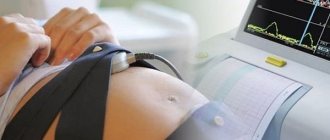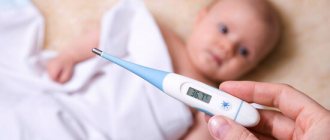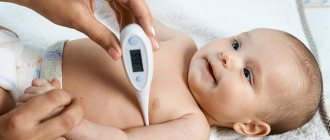Basal temperature can drop before ovulation (when estrogen surges) and after it. In the second case, a decrease in BT occurs due to embryo implantation, hormonal imbalance or before the onset of menstruation. During pregnancy, a one-day drop in BT occasionally occurs (indicators are restored the next day). If you fall for a long time, you should consult a doctor.
In this article we will talk about why basal temperature drops at different periods of the cycle. This will help planning women correctly interpret their schedule, and also tell them how not to miss the alarm bells that our body sends. If you are interested in finding out why your basal temperature has dropped, read on.
What is basal temperature?
This term, in preparation for and during pregnancy, is firmly part of every woman's vocabulary, so it seems that it is somehow connected with reproductive health. In fact, the word “basal” only means “basic, basic” and emphasizes the following fact: during the day, the body temperature of any person can vary significantly. After a gym session or a hearty lunch, it will be higher than while watching the news while lying on the couch. Temperature measured during the day carries little information about a person’s condition; only the lowest temperature point during the day matters, and it is this that is called basal.
Basal temperature is measured at the moment of greatest relaxation - in the first minutes after waking up, and a graph of its changes over several days can tell a lot. Particularly during the menstrual cycle, it can help calculate the day of ovulation.
What basal temperature should be during ovulation?
A woman’s body temperature during reproductive age changes under the influence of hormones, and it is not always equal to the classic 36.6 °C. The basal temperature already in the early stages of pregnancy rises to a more comfortable temperature for the fetus - slightly above 37 °C. However, it is much more important to understand how it behaves during the menstrual cycle: along with the concentration of luteinizing hormone in the blood and urine, a change in this indicator is one of the main signs of ovulation.
With the onset of menstruation, the basal temperature rises slightly, then drops to normal and remains at this level throughout the first phase of the menstrual cycle. Just before ovulation, due to rising estrogen levels, it briefly dips below normal. From the moment of ovulation, the production of estrogen decreases and progesterone increases, so the temperature rises sharply above the initial level and stays there throughout the second phase of the cycle, slowly decreasing every day.
The changes described above at the beginning of a possible pregnancy are, in fact, minimal - we are talking about fractions of a degree. However, a characteristic pattern in which the temperature “dives” down and then quickly “climbs” to new heights makes it possible to detect ovulation. This means preparing for the long-awaited conception.
Ovulation line
In order to judge the onset of ovulation, the rules established by the World Health Organization (WHO) are used:
Three temperature values in a row must be above the level of the line drawn over the previous 6 temperature values. The difference between the center line and the three temperature values must be at least 0.1 degrees on two days out of three and at least 0.2 degrees on one of those days.
If your temperature curve meets these requirements, then an ovulation line will appear on your basal temperature chart 1-2 days after ovulation.
Sometimes it is not possible to determine ovulation using the WHO method due to the fact that there are high temperatures in the first phase of the cycle. In this case, you can apply the “finger rule” to the basal temperature chart. This rule excludes temperature values that differ from the previous or subsequent temperature by more than 0.2 degrees. Such temperature values should not be taken into account when calculating ovulation if the overall basal temperature chart is normal.
The most optimal time for conception is the day of ovulation and 2 days before it.
How is basal temperature measured during preparation for pregnancy?
We will not give you false hopes and tell you that this is an easy task. Not at all: it requires high discipline, attentiveness and strict adherence to the rules. We are talking about the need to detect almost imperceptible fluctuations of a fraction of a degree, and any error in measurements can become critical. It's best if you get training from your doctor, but we'll also give you a guide with 10 main principles for measuring basal temperature in preparation for and in early pregnancy.
- Only a very accurate thermometer is suitable for measurement. It is best if it is a modern digital device. Read the operating instructions carefully and do not forget to change the batteries in a timely manner. The thermometer cannot be changed during the menstrual cycle - individual errors of different devices can distort the picture.
- Measurements are best taken in the rectum. Measurements in the vagina or mouth are acceptable, but the rectal method is considered to be the most reliable. Whatever method you choose, do not change it during the cycle. Armpit measurements are not suitable for tracking ovulation because they do not provide the necessary accuracy.
- Measurements are taken only in the morning, immediately after waking up. You cannot get out of bed or make sudden movements; even a short trip to get a thermometer and back to the other end of the room can ruin everything. Prepare a thermometer the night before and place it so that it is at arm's length.
- To avoid spoiling the readings, lie still and do not change your position. Try to do everything to prevent the brain, and after it the body, from switching to “work speed” - do not think about plans for the day, about important matters and problems. Ideally, don't even open your eyes.
- Basal temperature should be measured every day at approximately the same time. A schedule in which you get up, for example, at 6 am on weekdays, and at 10 am on Saturday and Sunday, is not suitable. To ensure the necessary accuracy, you will have to set the alarm clock at 6 a.m. on weekends, or at most 7 a.m.
- The measurement should be taken after 3 or more hours of restful sleep. Try to eliminate all factors that can interrupt your sleep, in particular, do not drink a lot of fluids in the evening so that you do not have the urge to go to the toilet at night. If you slept less than 3 hours, the result may be significantly distorted.
- Measuring your basal temperature during the day when preparing for pregnancy is only possible in extreme cases, for example, if you work night shifts. Before this, you need to sleep at least 3 hours. And, of course, if you are planning to get pregnant, you need to change your work schedule or move to another job.
- Once the measurements are completed, immediately write down the result. Don't rely on memory - in the time it takes to visit the toilet or put on the kettle, the brain can switch to some important thought, and the numbers will fly out of your head. It is best to record measurements electronically. Microsoft Excel or another similar program will allow you to automatically draw a basal chart in preparation for pregnancy, which is much more visual than just a column of numbers on a piece of paper.
- Please make comments about any unexpected deviations in measurements. If you understand what led to them, write down the reason. This could be a slight illness, alcohol, sex before bed, taking certain medications, stressful conditions, severe physical activity and some other factors.
- If you catch ARVI, flu or another disease that causes your body temperature to rise significantly, feel free to stop taking measurements. While the immune system is fighting the disease, you will not see anything useful on the chart. Also, measurements are absolutely meaningless when taking oral contraceptives.
When to contact a gynecologist?
To determine the correct functioning of the reproductive system, it is necessary to plot the basal temperature for at least 4 cycles. The data obtained should be shown to a gynecologist; only a specialist will be able, using the curve from the graph, to make a preliminary diagnosis and prescribe the necessary further examination.
Under what conditions and additional symptoms should you immediately contact a gynecologist:
| Graph Data | Additional symptoms |
| Having an anovular cycle more than twice every 12 months. | Pregnancy does not occur. Possible absence of menstruation. |
| The duration of the 2nd phase is 11 days or less. | Change in the nature of menstruation, heavy or scanty, lack of conception. |
| The duration of the menstrual cycle is less than 20 days and more than 36 days. | No pregnancy, profuse discharge with a large number of clots. |
| Instability of the menstrual cycle. | The presence of intermenstrual discharge, pain and fever. |
| The curve has slight deviations, while the basal temperature itself is higher than normal. | Lack of pregnancy or frequent miscarriages. Possible failure of menstruation or absence of menstrual flow. |
| Strong temperature changes in the 1st phase of the cycle | Pain in the appendage area, additional vaginal discharge |
| Changes in basal temperature indicators, upward or downward, during pregnancy. | Pain in the lower abdomen and bleeding. |
You also need to consult a specialist if the basal temperature measurement schedule is without deviations, but there is no pregnancy. Making a diagnosis on your own and starting treatment is dangerous and can result in complete infertility.
How to measure basal temperature during pregnancy?
In exactly the same way as when planning a pregnancy. It is advisable that you use the same thermometer - if it “lies” a little, at least the readings will be overestimated or underestimated in the same direction as before.
The temperature chart during pregnancy is, in fact, nothing interesting. The most comfortable temperature for fetal development is 37.0–37.3 °C, and your body will try to maintain it throughout the entire period of gestation. Basal temperature in pregnant women can change significantly only in case of pathologies, for example, with a frozen pregnancy or a threat of miscarriage. However, in such situations, the body lets you know that something has gone wrong with nagging pain in the lower abdomen or bleeding. In this case, you should not wait until the morning to take measurements: any dangerous symptoms are a reason to immediately contact your doctor.
Hyperprolactinemia
Due to an increase in the level of the pituitary hormone prolactin, which is responsible for maintaining pregnancy and lactation, the basal temperature graph in this case may resemble the graph of a pregnant woman. Menstruation, just like during pregnancy, may be absent. An example of a basal temperature chart for hyperprolactinemia
What should a basal schedule look like when preparing for pregnancy?
Describing how basal temperature changes during the menstrual cycle is useful information, but can be difficult to understand without specific examples. So let's look at some graphs that visually show what measurements you can get.
Normal menstrual cycle
Normal menstrual cycle schedule
During the normal course of the menstrual cycle, you can see two different phases on the graph - in the first, the average level of basal temperature is lower than in the second, and ovulation serves as their boundary. It is not necessary that your schedule is divided into two equal parts of 14 days, as in this example. The duration of the second phase of the cycle for different women can be from 12 to 16 days, and the first can vary within even wider limits. There is nothing unusual in this, just the individual characteristics of the body. However, different cycles of a particular woman should follow the same scenario. After a couple of months of measurements, you will already roughly understand what day of the cycle ovulation should occur.
This graph gives an understanding of what basal temperature is normally observed in preparation for pregnancy. In the second phase it should be 0.3–0.6 °C higher than the average level of the first period. At the same time, a drop in the temperature curve is observed at the end of the cycle, before the onset of menstruation. And, of course, the preovulatory drop followed by a rise is important for the expectant mother.
Anovulatory cycle
Anovulatory cycle chart
In the anovulatory cycle, ovulation does not occur, and hormonal levels change slightly. Throughout the entire cycle, the basal temperature remains almost at the same level - around 36.6 ° C, and the graph does not show pronounced phases and drops that are observed in a normal menstrual cycle.
If your temperature curve looks like this in the first month of measurements, there is no need to panic. Every woman has one anovulatory cycle per year, sometimes more. It’s just that your reproductive system periodically needs rest, and it arranges it for itself during periods during which it is impossible to get pregnant. However, if such a picture is observed for more than two months in a row, you need to consult a doctor - this is no longer a rest, but a possible sign of infertility.
Hormonal problems
Let's look at what a basal temperature graph might look like for various hormonal disorders.
Diagram for corpus luteum deficiency
The corpus luteum forms after ovulation and produces progesterone, which is necessary to prepare the endometrium for implantation of a fertilized egg. If the corpus luteum produces little progesterone, an already begun pregnancy may be terminated.
This condition can be calculated by the slow rise in temperature in the second phase, and for its treatment the doctor will prescribe hormonal drugs.
Schedule for estrogen deficiency
If a high level of progesterone leads to an increase in basal temperature, then an increase in estrogen production leads to a decrease in it. It is thanks to them that the temperature drops before ovulation. With estrogen deficiency, the likelihood of fertilization decreases significantly.
This condition can be identified by an unexpectedly high temperature at the beginning of the cycle, a slow increase in the middle, and a temperature above normal for the second phase. It will not be possible to detect ovulation using such a schedule. In case of estrogen deficiency, hormonal medications are also prescribed.
Pregnancy
Schedule during pregnancy
You determined the day of ovulation using measurements, you have already had that same sex. Keep monitoring - you may soon be able to detect pregnancy even before the test shows two lines!
In early pregnancy, basal temperature drops on the day when the egg implants. The characteristic implantation retraction divides the second phase into two, and a third phase appears in your chart, indicating that pregnancy has begun. It is worth remembering possible inaccuracies in measurements and it is better to wait until your doctor confirms this joyful fact. But, most likely, you can already be congratulated - you have begun your journey to becoming the best mother to the best baby in the world!
Pregnancy tests
Dip and tablet tests that detect pregnancy using a urine sample, as well as blood tests for pregnancy, are related to the hCG hormone. Its blood level doubles every two days in the first weeks of pregnancy. To obtain a reliable result, it is recommended to take a laboratory blood test for hCG no earlier than 3-4 days, and use test strips no earlier than 7 days after a missed period. If the test result is negative and there is no menstruation, you need to repeat the test or consult a doctor.











